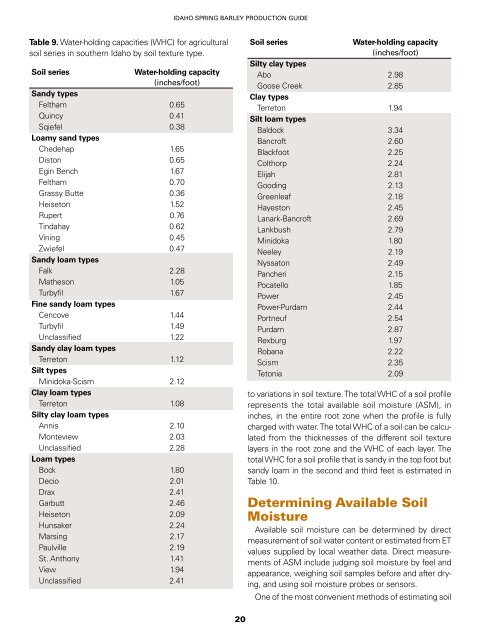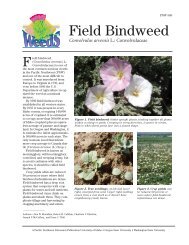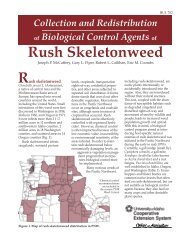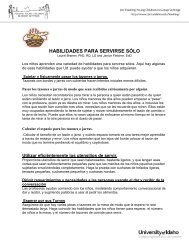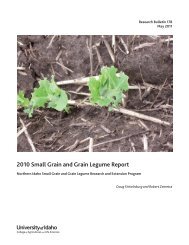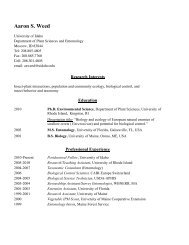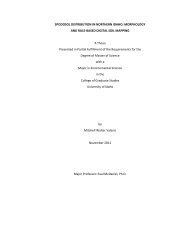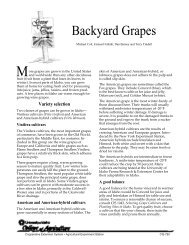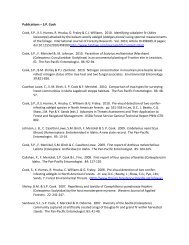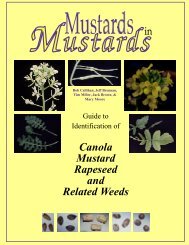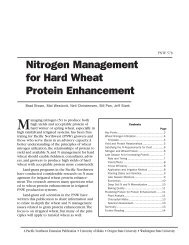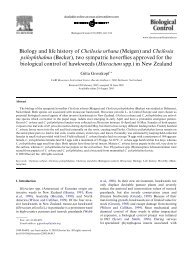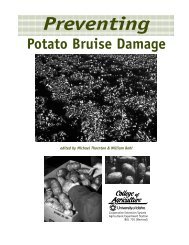Spring Barley Production Guide - College of Agricultural and Life ...
Spring Barley Production Guide - College of Agricultural and Life ...
Spring Barley Production Guide - College of Agricultural and Life ...
You also want an ePaper? Increase the reach of your titles
YUMPU automatically turns print PDFs into web optimized ePapers that Google loves.
Table 9. Water-holding capacities (WHC) for agricultural<br />
soil series in southern Idaho by soil texture type.<br />
Soil series Water-holding capacity<br />
(inches/foot)<br />
S<strong>and</strong>y types<br />
Feltham 0.65<br />
Quincy 0.41<br />
Sqiefel 0.38<br />
Loamy s<strong>and</strong> types<br />
Chedehap 1.65<br />
Diston 0.65<br />
Egin Bench 1.67<br />
Feltham 0.70<br />
Grassy Butte 0.36<br />
Heiseton 1.52<br />
Rupert 0.76<br />
Tindahay 0.62<br />
Vining 0.45<br />
Zwiefel 0.47<br />
S<strong>and</strong>y loam types<br />
Falk 2.28<br />
Matheson 1.05<br />
Turbyfil 1.67<br />
Fine s<strong>and</strong>y loam types<br />
Cencove 1.44<br />
Turbyfil 1.49<br />
Unclassified 1.22<br />
S<strong>and</strong>y clay loam types<br />
Terreton 1.12<br />
Silt types<br />
Minidoka-Scism 2.12<br />
Clay loam types<br />
Terreton 1.08<br />
Silty clay loam types<br />
Annis 2.10<br />
Monteview 2.03<br />
Unclassified 2.28<br />
Loam types<br />
Bock 1.80<br />
Decio 2.01<br />
Drax 2.41<br />
Garbutt 2.46<br />
Heiseton 2.09<br />
Hunsaker 2.24<br />
Marsing 2.17<br />
Paulville 2.19<br />
St. Anthony 1.41<br />
View 1.94<br />
Unclassified 2.41<br />
IDAHO SPRING BARLEY PRODUCTION GUIDE<br />
20<br />
Soil series Water-holding capacity<br />
(inches/foot)<br />
Silty clay types<br />
Abo 2.98<br />
Goose Creek 2.85<br />
Clay types<br />
Terreton 1.94<br />
Silt loam types<br />
Baldock 3.34<br />
Bancr<strong>of</strong>t 2.60<br />
Blackfoot 2.25<br />
Colthorp 2.24<br />
Elijah 2.81<br />
Gooding 2.13<br />
Greenleaf 2.18<br />
Hayeston 2.45<br />
Lanark-Bancr<strong>of</strong>t 2.69<br />
Lankbush 2.79<br />
Minidoka 1.80<br />
Neeley 2.19<br />
Nyssaton 2.49<br />
Pancheri 2.15<br />
Pocatello 1.85<br />
Power 2.45<br />
Power-Purdam 2.44<br />
Portneuf 2.54<br />
Purdam 2.87<br />
Rexburg 1.97<br />
Robana 2.22<br />
Scism 2.35<br />
Tetonia 2.09<br />
to variations in soil texture. The total WHC <strong>of</strong> a soil pr<strong>of</strong>ile<br />
represents the total available soil moisture (ASM), in<br />
inches, in the entire root zone when the pr<strong>of</strong>ile is fully<br />
charged with water. The total WHC <strong>of</strong> a soil can be calculated<br />
from the thicknesses <strong>of</strong> the different soil texture<br />
layers in the root zone <strong>and</strong> the WHC <strong>of</strong> each layer. The<br />
total WHC for a soil pr<strong>of</strong>ile that is s<strong>and</strong>y in the top foot but<br />
s<strong>and</strong>y loam in the second <strong>and</strong> third feet is estimated in<br />
Table 10.<br />
Determining Available Soil<br />
Moisture<br />
Available soil moisture can be determined by direct<br />
measurement <strong>of</strong> soil water content or estimated from ET<br />
values supplied by local weather data. Direct measurements<br />
<strong>of</strong> ASM include judging soil moisture by feel <strong>and</strong><br />
appearance, weighing soil samples before <strong>and</strong> after drying,<br />
<strong>and</strong> using soil moisture probes or sensors.<br />
One <strong>of</strong> the most convenient methods <strong>of</strong> estimating soil


